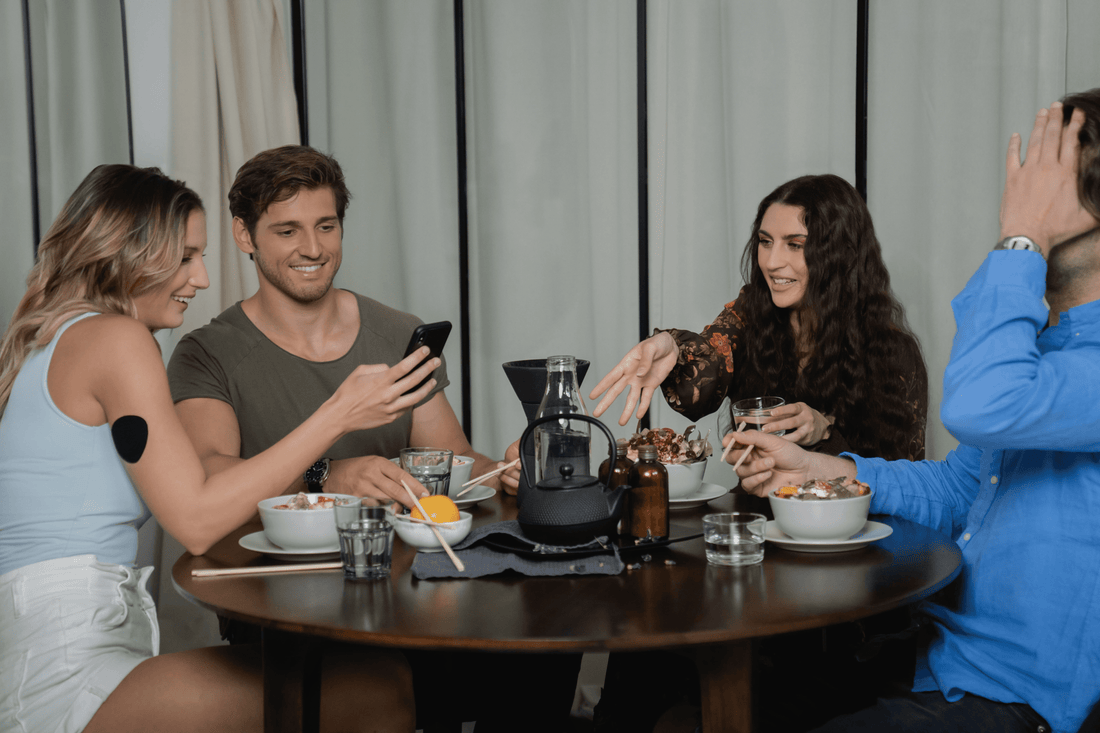Your dinner influences your sleep and thus your blood sugar the following day. That's why we have a few tips for you on how to improve your blood sugar reactions when you go out to eat, but also at home.
For many of us, dinner is the highlight of the day. Lunch was four to five hours ago, and now you feel your energy waning and your concentration slipping. You can't wait to get home and see what's in your fridge. This is a typical sign that your body is hungry and wants to refuel.
Other signals that your body is ready to eat:
- Dizziness or onset of headache
- Mood worsens and you feel irritable and short tempered
- Your hands start to shake
- Your stomach growls
- You can't focus on anything but the food
If you're always hungry before dinner, boost your energy intake in the afternoon with a variety of healthy snacks.
And even if you're not a big snacker, a healthy dinner is always a smart choice to balance your blood sugar before bed.
What is a healthy dinner?
A healthy dinner is a balanced meal that includes different food groups and different colors. At the end of dinner, you should feel full, but not overly full, so that you can sleep well.
A healthy dinner contains all three macronutrients: carbohydrates, fats and proteins. All three provide you with energy and important nutrients that keep you healthy. If you leave out one area, you risk missing a certain nutrient or fiber, which makes it harder to stick with the diet long-term.
After a long day at work, driving to and from the kids' activities, or a strenuous workout at the gym, the last thing most of us want to do is spend an hour in the kitchen preparing a complicated dinner, right? So let's keep it simple by following a few easy steps.
Make your own dinner at home
The advantage of cooking at home is that you have full control over ingredients and portion sizes. Even seemingly healthy restaurant meals can contain unnecessary sugar, which can have a negative impact on blood sugar levels.
One of our favorite examples is the blood sugar response to a restaurant-ordered ramen versus a homemade one.

The principle of the healthy plate
Visualizing macronutrients can help you create a healthy dinner.
Half of the plate is reserved for vegetables: salad, freshly cut vegetables for dipping or roasted.
A quarter of the plate is for high-quality carbohydrates, including whole grains, starchy vegetables and legumes.
The last quarter is reserved for plant or animal protein.
Finally, healthy fats such as olive oil or fresh avocado are added.
Here's an easy-to-prepare recipe that doesn't take much time and supports healthy blood sugar.
Recipe Tip: Green Shakshuka
To prepare this blood sugar friendly recipe, you will need the following ingredients:
- 1 clove garlic
- 1 green bell bell pepper
- 5 g mint
- 20 g parsley
- 1 piece leek
- 50 g spinach
- 100 g frozen peas
- 0,5 pcs. Lemon (juice)
- 200 g feta cheese (divided)
- 4 eggs
- 1 pinch of salt
- 1 pinch of pepper
- 1 pinch of nutmeg
- 1 pinch vegetable oil
Preparation steps:
- Peel and finely chop the garlic. Remove the core of the peppers and cut the peppers into cubes.
- Chop mint and parsley. Halve leeks lengthwise and cut into thin slices.
- Heat 1 tablespoon vegetable oil in a large skillet over medium heat. Add garlic and sauté for approx. 2 min.
- Add bell bell pepper and leek and sauté for about 4 minutes. Season with cumin and freshly grated nutmeg. Season to taste with salt and pepper.
- Add spinach, peas, chopped mint and half of the parsley to the pan. As soon as the spinach begins to shrivel, squeeze the lemon half and add the juice.
- Crumble half of the feta cheese into the pan and stir.
- Using a spatula, prepare two small holes in the leek mixture and crack the eggs into them. Reduce heat.
- Season eggs with salt. Cook for 10-12 minutes until the eggs are set and the yolks are still soft. For this it is best not to stir now.
- Crumble the remaining feta cheese and sprinkle over the shakshuka. Garnish with the remaining parsley and season with salt and pepper. Buon Appetite!
Eat out
The healthy plate is also a fantastic way to judge dishes when you eat out. It's a great way to set the tone for a balanced blood sugar meal.
Many restaurant meals are 50% carbohydrate and 50% protein, with two small pieces of broccoli on the side. And it gets even more unbalanced when you enjoy the delicious bread that's often served as an appetizer. It gets your blood sugar levels going right away. The bread at the beginning spikes your blood sugar quickly, and by the time you're done eating, it's back downhill and you're craving energy in the form of dessert.
We assume that you don't actually want that.
So let's look at a few tricks you can use if you're eating out and still have a blood sugar-friendly response.
Choose the healthiest carbohydrates
Choose healthy, complex carbohydrates like whole grains and vegetables. Because they contain fiber and are less processed, these foods don't cause blood sugar levels to fluctuate as much.
Cover Your Carbs
When carbohydrates are consumed as part of a meal that also contains proteins and fats, they have a slower effect on blood sugar.
Eat your food in the right order.
Start with vegetables in the form of a salad or eat the vegetables on your plate first. Follow with protein and fat, then starchy foods like beans or potatoes, and finally rice or pasta.
Drink smart
Choose water. It's that simple.
When we drink alcohol, we give our liver a lot to do. Therefore, it is best to avoid it. But if you do drink alcohol, here's what you should keep in mind: Light to moderate alcohol consumption can lead to lower blood sugar levels in the short term. That's because alcohol can reduce the liver's ability to produce and pump new glucose into the blood, and light drinking can lead to increased short-term insulin sensitivity.
Eat slowly
That's how you know when you're full. It's okay if you don't eat everything on your plate. You could even ask for a take-out box (or bring one yourself) so you have some left over the next day. This could be an interesting glucose experiment to see how differently your body responds to the same meal on two days.
Find the right time
If you eat too close to bedtime, it will affect your sleep - and not in a good way. Unfortunately, poor sleep also affects your blood sugar the next day.
Therefore, as a rule of thumb, you should eat at least 3 hours before bedtime so that your body has enough time to digest before you go to bed.
Move
Walk home or park your car farther away so you have a few more steps to take before you go home. Just 10 minutes of walking can lower blood sugar levels after a meal.
It's as simple as that. Don't worry too much and enjoy your meal at the restaurant.
With a little thought or planning, you can easily improve your blood sugar response and enjoy your dinner.
Whether you cook for yourself or eat out.
To find out what works best for you, opt into our Hello Sugar program and learn more about tips and tricks to balance your blood sugar.





